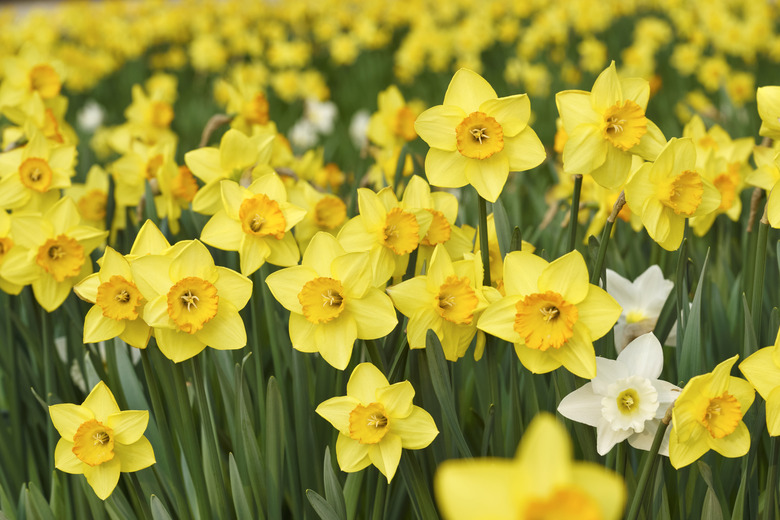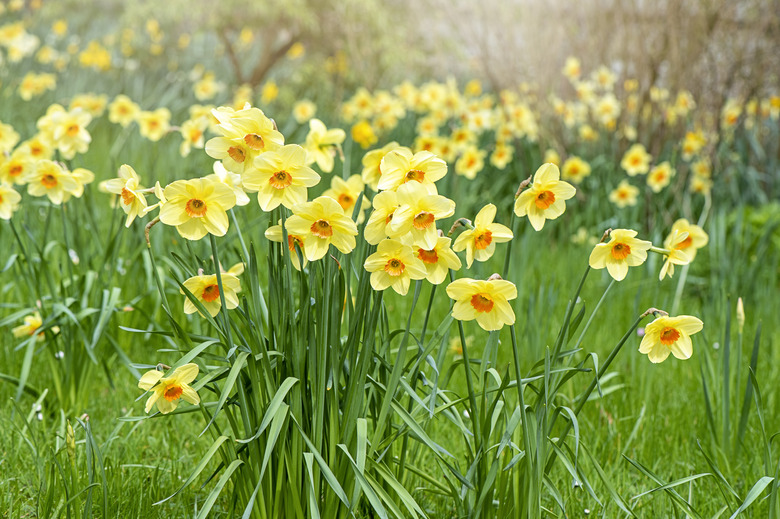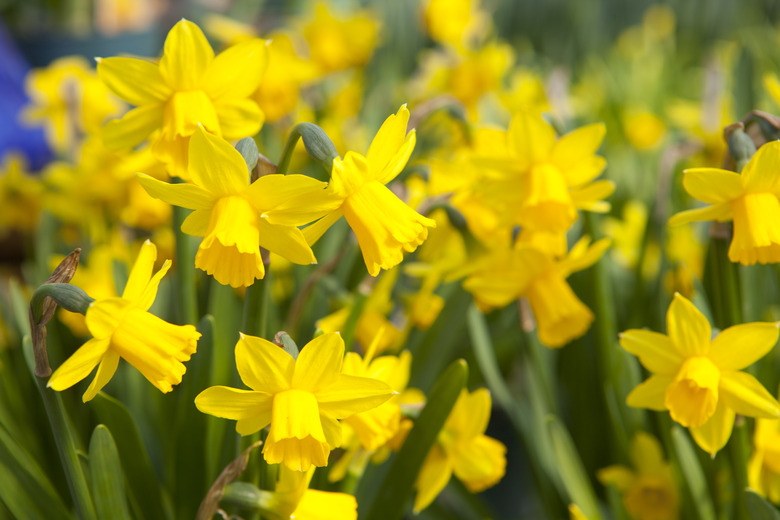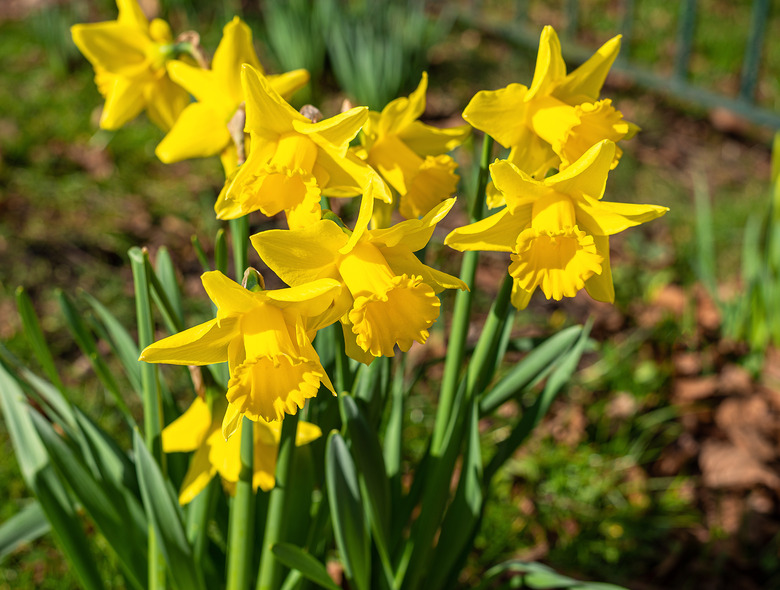How To Grow Daffodils
We may receive a commission on purchases made from links.
Available in bright yellow, red, pink, orange, white, and bicolor, daffodils (Narcissus spp., USDA zones 3-9) proudly herald spring's arrival. They're a perfect spot of cheer after a gloomy winter and make a delightful bouquet when you want to bring the outdoors inside. They will grow to about 2 feet tall but spread only about a foot so you can tuck them anywhere you need a little spring morale boost.
Best Uses for Daffodils
Best Uses for Daffodils
Perennial daffodils will keep coming back again year after year, so choose a planting location where their blooms are welcome to stay. They work well as border plants, or you can plant large groupings of them together for a more impactful display. Although you can plant different types of daffodils, it is generally believed that gardens look best when groups are the same. Garden designers claim that you can plant a group of yellow daffodils next to a group of white ones but shouldn't mix yellow and white in the same group. The final decision, of course, is yours to make based on what you like, however.
Because they stay compact, you can also tuck daffodils in and around the other perennials in your garden, enjoying their early flowers until your other plants wake up for the growing season.
Daffodils make excellent cut flowers and look beautiful in a nice vase but be sure to keep them to themselves. Cut daffodils secrete a fluid that causes other flowers to wilt. As such, it's best not to mix your daffodils with other flowers when creating a bouquet.
How to Grow Daffodils
How to Grow Daffodils
- Common Name: Daffodil
- Botanical Name: Narcissus
- When to Plant: In late fall before the ground freezes
- USDA Zones: 3-9
- Sun Exposure: Full sun
- Soil Type: Loamy, well-drained soil
- When it's in Trouble: Wilting, failure to bloom, yellow-streaked leaves
- When it's Thriving: Bright flowers sit atop long, healthy stems
Starting Daffodils From Daffodil Bulbs
Daffodils grow from large bulbs that are usually 2 or 3 inches long. Before planting them, work a low-nitrogen 5-10-10 fertilizer into the ground across the entire planting area, if a soil test indicates the need. Use about 1/4 cup of fertilizer per square foot of soil.
Dig a planting hole or if you're planting many daffodils in a row, dig a trench. Dig far enough that your bulb will sit 4 to 5 inches deep in the soil. Generally, the top of a planted bulb should be two times as deep as the bulb is tall. The top of a 2-inch bulb, for example, should sit 4 inches below the surface of the soil. Space the daffodil bulbs 3 to 6 inches apart. Place your bulb in the bottom of the planting hole with the tip pointing up. You can then backfill the hole and water your bulbs.
In What Zone Do Daffodils Grow Best?
In What Zone Do Daffodils Grow Best?
Daffodils do well in USDA hardiness zones 3 through 9, depending on cultivar. When your flowers bloom depends on where you live within those zones. In zones 3 through 6, daffodils appear in early spring. In warmer regions, they may appear a bit earlier, coming at the end of winter. The colder your region, the later your daffodils will bloom.
When Should You Plant Daffodils?
When Should You Plant Daffodils?
Most plants require spring planting, but daffodils are a bit different. The best time to plant daffodil bulbs is in the fall. The ideal soil temperature for bulb planting is 60 degrees Fahrenheit at a depth of about 6 inches. This is usually about two to four weeks before the ground freezes. You want to plant when the ground is cool but before it freezes and causes planting to become difficult.
In zones 8 and 9 where the ground isn't likely to freeze, plant daffodils a few weeks before your first expected frost in October or November.
Soil, Sunlight and Water Recommendations for Daffodils
Soil, Sunlight and Water Recommendations for Daffodils
Daffodils happily soak up full sun and like a soil pH that is neutral to slightly acidic. Far more critical than the pH of your soil is its moisture level. Daffodils like loamy, well-draining soil. If the soil is too wet, your daffodil bulbs will rot over the winter, and the flowers won't come back. If your soil is heavy, amend it with organic matter, such as compost, leaf mold, or peat moss before you plant.
When you notice your daffodils starting to poke through the soil, keep the ground around them evenly moist. If your daffodils get too dry during this time, they may abandon the flowering process. They will need to be watered about once a week from now until they bloom. After that, you can stop watering and leave the plants to their own devices.
If you feel that your daffodils aren't performing as well as they could, fertilize them with the same fertilizer you worked into the soil when planting them. Do this after the plants flower. The fertilizer won't do much this year, but it will allow the daffodil bulb to gather and store nutrients for next year's bloom.
It's OK to deadhead your daffodils after the flowers die if you don't like the way they look but don't cut the leaves down until after they have died.
Over time, your daffodil bulbs will expand by forming new bulbs. As a result, your daffodils could become overly crowded or hesitant to flower. If this happens, divide your daffodil plants in the fall. Place a golf tee or stake in the ground next to your underperforming plant so you can easily find it when it's time to divide it in the fall when it has died back. You may find you need to divide your daffodils every three to five years.
How to Propagate Daffodils
How to Propagate Daffodils
You propagate daffodils by dividing them, as you can with many perennials. You have the option of dividing your daffodils in the spring when they are done flowering, but then you have to store your bulbs in a cool dry place like your garage or basement until fall planting time. It is far easier to divide your plants in the fall when you can replant them immediately.
Dig up the daffodil clump and separate the bulbs gently with your fingers. You don't want to cut into the bulb, as this can cause disease. Bulbs typically come apart easily. If you see a small bulb that is still attached to its parent, leave it be. These immature bulbs aren't quite ready to strike out on their own, and you could damage the plants by trying to separate them.
How to Winterize Daffodils
How to Winterize Daffodils
When your daffodils finish their early spring bloom, it is perfectly fine to deadhead them if you wish. Do not, however, cut back the plant's stems and leaves. They are busy collecting the nutrients your bulb will need to survive the winter. Leave them to die back naturally when they have finished their important work.
You can cut the leaves back to ground level after they have died. You can also pull them off the bulb by pulling on them lightly as you twist them. In the fall, place a few inches of mulch over the daffodil bulbs to give them a little extra insulation from the cold. Two or 3 inches should suffice.
If you have planted your daffodils in containers, bring the containers inside for the winter if your garden is in zones 3 through 5. Place them in a well-ventilated area where the temperature won't climb above 50 degrees Fahrenheit. Basements and unheated garages are both perfect spots for overwintering containerized daffodils. If your garden is in zone 6 or warmer, you can leave the containers outside during winter.
Common Pests and Other Problems for Daffodils
Common Pests and Other Problems for Daffodils
Daffodils are simple to grow and usually do so without pests or problems. Slugs and snails do sometimes visit daffodils, but you can easily pluck them off if you notice them.
Although rare in home gardens, narcissus bulb flies and narcissus nematodes can affect daffodils. If you see flies that look like tiny bumble bees hanging around your plants, cut back your daffodil leaves as soon as they die and then work the top few inches of soil. This prevents adult females from easily laying eggs in the holes where your daffodil stems once were.
If the flies persist, dig up your daffodil bulbs as soon as their leaves die back and soak the bulbs in 109-degree water for 40 minutes. Dry your bulbs and then store them in a cool, dry place until you can plant them again in the fall.
The narcissus nematode causes browning stems with random stem thickness. You will also see small yellow patches on your daffodil leaves, usually along the edge. The easiest way to deal with narcissus nematodes is to simply dig up and discard affected plants. If you do, try to keep new daffodil plantings at least 3 feet away from areas where nematodes are present.
Common Diseases for Daffodils
Common Diseases for Daffodils
The most often encountered daffodil virus is the yellow stripe virus. As its name suggests, the disease causes yellow streaks to appear on the plant's leaves. The disease can also cause white streaks in the daffodil flowers and misshapen leaves.
There is no cure for the yellow stripe virus, which is transmitted by aphids. To avoid disease, buy your daffodil bulbs only from trusted suppliers and choose newer varieties or cultivars. Newer daffodil strains are more likely to have been bred with virus resistance. If the disease is present, remove and destroy the affected plants.
Daffodils are also prone to bulb rot, but this is not a problem unless you let them sit in heavy, wet soil. If your soil drains well, rot shouldn't be an issue.
References
- The American Daffodil Society: Guidelines for Growing Daffodils
- Miracle-Gro: How to Grow Daffodils
- Dutch Grown: How to Grow Daffodils?
- Missouri Botanical Garden: Narcissus (group)
- The Old Farmer's Almanac: Growing Daffodils
- Royal Horticultural Society: Daffodil Viruses
- University of Florida: Narcissus Bulb Fly



